Bird coloration is a fascinating aspect of avian evolution, involving pigments like melanin and carotenoids, shaped by sexual selection, natural selection, and environmental influences.
1.1 The Evolutionary Significance of Bird Colors
Bird coloration plays a critical role in evolution, serving as a key survival and reproductive strategy. Colors often signal health, genetic quality, and fitness to potential mates or rivals, influencing mate choice and sexual selection. Bright plumage can attract mates, while dull colors may aid in camouflage to avoid predators. Evolutionary pressures, such as predation and environmental conditions, shape these traits. For example, species with carotenoid-based colors exhibit sexual dichromatism, highlighting the role of diet and pigment availability. Additionally, color polymorphism accelerates speciation, as diverse traits can lead to reproductive isolation. Thus, bird colors are dynamic, evolving in response to ecological and social demands.
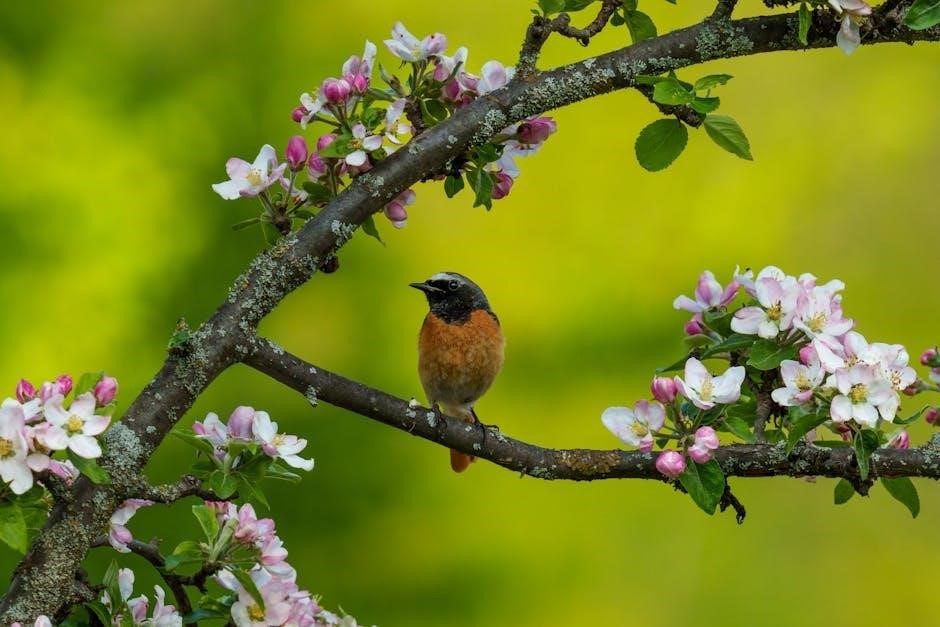
1.2 Overview of Pigment Types in Bird Feathers
Bird feather colors are primarily derived from two types of pigments: melanins and carotenoids. Melanins, produced by birds internally, create browns, blacks, and grays, while carotenoids, obtained from diet, produce vibrant reds, oranges, and yellows. A third, less common pigment, porphyrins, generates pink and green hues. These pigments interact with feather microstructure to enhance or alter color perception. For example, melanin-based colors are more resistant to fading, while carotenoids signal dietary health. The combination and distribution of these pigments determine the wide variety of colors seen in bird plumage, enabling species-specific appearances and adaptive visual displays.
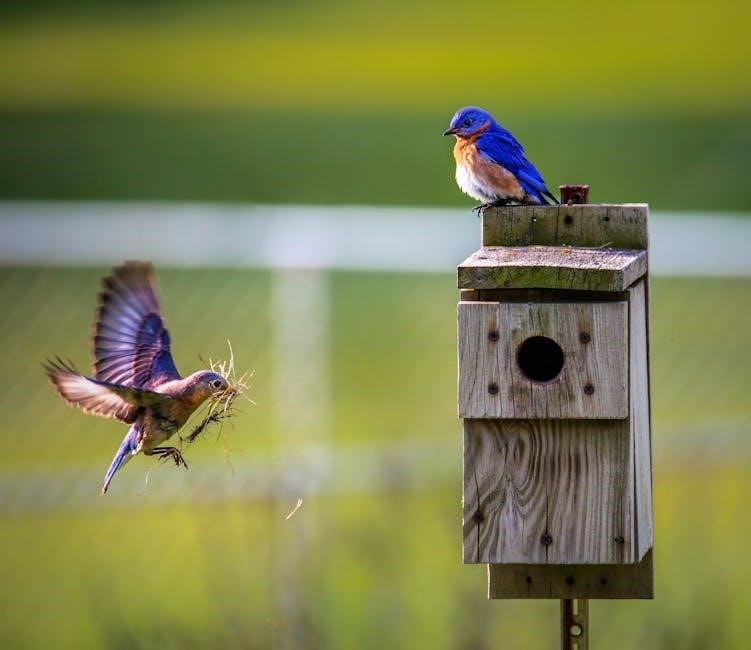
Pigments and Their Role in Bird Coloration
Birds’ vibrant colors stem from melanin and carotenoid pigments. Melanin produces browns and blacks, while carotenoids create reds and yellows, each essential for visual communication and survival strategies.
2.1 Melanin: The Primary Pigment in Bird Feathers
Melanin is the most common pigment in bird feathers, responsible for shades of black, brown, and gray. It is produced by melanocytes in the skin and deposited into feathers during growth. Two types of melanin—eumelanin (black and dark brown) and pheomelanin (lighter browns)—create diverse coloration patterns. Melanin not only contributes to color but also enhances feather strength and resilience. Research, such as a study in Nature Ecology & Evolution, highlights how melanin-based traits evolve rapidly, influenced by environmental pressures. For example, the kiwi’s mottled plumage likely evolved for camouflage, showcasing melanin’s adaptive role in avian survival and communication strategies.
2.2 Carotenoids: Vibrant Colors and Their Origin
Carotenoids are responsible for the vibrant red, orange, and yellow hues in bird plumage, derived from dietary sources like plants and insects. Birds cannot synthesize carotenoids, so their presence reflects foraging behaviors and environmental availability. These pigments play a crucial role in signaling health and genetic quality, as brighter colors often correlate with stronger immune systems and higher mating success. For example, studies on grackles and passerines highlight how carotenoid-based coloration varies geographically, influenced by resource access. This adaptability underscores their evolutionary significance in avian communication and mate choice, making carotenoids a key factor in sexual selection and species diversification.
Evolutionary Drivers of Bird Coloration
Bird coloration evolves due to sexual selection, natural selection, and environmental pressures, driving species diversification and adaptation through vibrant plumage traits that enhance survival and mating success.
3.1 Sexual Selection and Plumage Coloration
Sexual selection plays a pivotal role in shaping bird plumage coloration, as vibrant and elaborate traits often serve as signals for attracting mates and showcasing genetic quality. Bright colors, such as those produced by carotenoids, are frequently used by males to demonstrate health and fertility, influencing female choice. This selective pressure drives the evolution of striking feather patterns and hues, which can vary significantly between species. For example, species with carotenoid-based colors often exhibit higher levels of sexual dichromatic traits. Additionally, sexual selection can lead to rapid speciation, as distinct plumage features reinforce reproductive isolation. This dynamic highlights how mate choice shapes avian diversity.
3.2 Natural Selection and Camouflage Strategies
Natural selection has profoundly shaped bird coloration, particularly through camouflage strategies that enhance survival by concealing individuals from predators. Many bird species exhibit plumage patterns and colors that blend seamlessly with their habitats, such as forest canopies or grasslands. For instance, dull and mottled hues can mask a bird’s presence, while cryptic coloration helps avoid detection. Studies suggest that predation pressure has driven the evolution of these traits, with species in high-predator environments displaying more effective camouflage. Additionally, fossil records, such as the Baminornis zhenghensis, provide insights into how ancestral coloration strategies may have evolved to adapt to environmental challenges over time.

Environmental Influences on Bird Colors
Environmental factors significantly influence bird coloration, with geographical and climatic variations shaping plumage hues and patterns to suit regional habitats and light conditions effectively.
4.1 Geographic Variation in Plumage Colors
Geographic variation in bird plumage colors is influenced by regional environmental conditions and evolutionary pressures. Birds in different habitats often exhibit distinct color patterns to adapt to local light conditions, predators, and mates. For instance, species in dense forests may have darker plumage for camouflage, while those in open areas tend to be lighter. A study analyzing 516 bird species found significant correlations between geographic distribution and color intensity. This variation highlights how environmental factors drive the evolution of plumage colors, enabling birds to thrive in diverse ecosystems. Such adaptations underscore the dynamic interplay between geography, climate, and avian coloration.
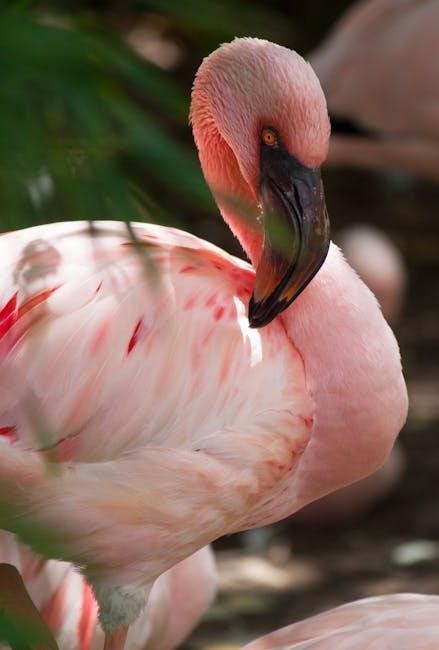
4.2 Climate and Light Conditions as Color Determinants
Climate and light conditions significantly influence bird plumage colors, with adaptations varying across environments. Birds in sunny climates often exhibit lighter colors to reflect solar radiation, aiding thermoregulation and visibility. In contrast, those in shaded habitats may have darker hues to absorb more light. Melanin and carotenoids play roles in these adaptations, affecting color intensity and saturation. Light pulsation and environmental factors also shape these traits, enhancing survival and communication. Such color variations demonstrate how avian coloration evolves in response to specific climatic and light-related pressures, ensuring optimal adaptation to their ecological niches while maintaining functional benefits like thermoregulation and predator avoidance.
Behavioral and Social Aspects of Bird Coloration
Bird coloration plays a critical role in social interactions, signaling health, status, and quality; Bright colors often attract mates, while dull hues may indicate subordinate status.
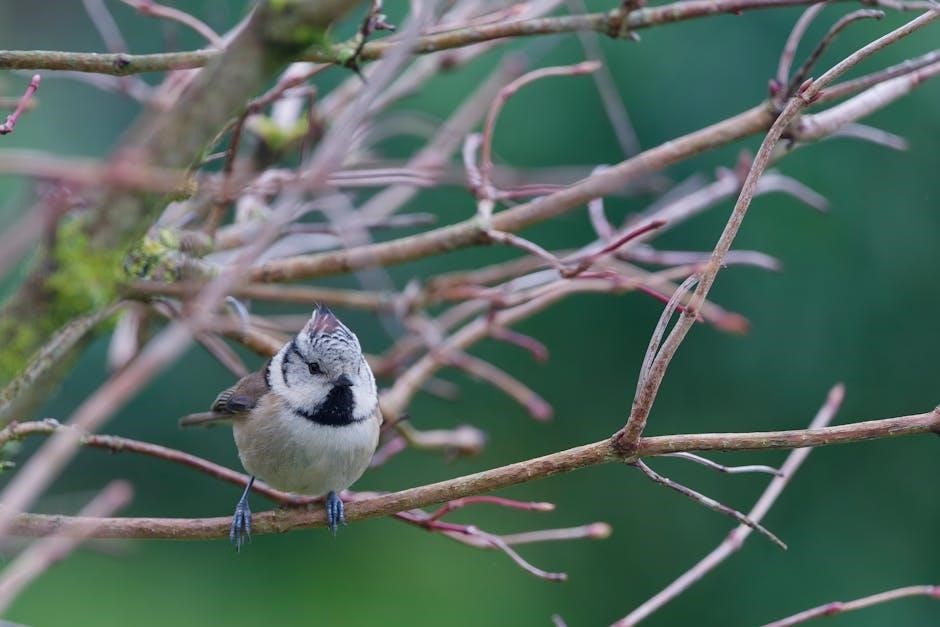
5.1 Color as a Signal of Health and Quality
Bird coloration serves as a vital signal of health and quality, often influencing social interactions. Bright, vibrant colors, particularly those derived from carotenoid pigments, indicate access to nutritious food sources and strong immune systems. Birds with more intense coloration are frequently perceived as healthier and of higher quality, making them more attractive to mates. This signaling is crucial in mate choice, as it reflects an individual’s ability to thrive and reproduce. Additionally, feather condition and color intensity can signal resistance to parasites and environmental stressors, further emphasizing the role of coloration in conveying an individual’s overall fitness and genetic quality.
5.2 The Role of Color in Mate Choice and Mating Rituals
Bird coloration plays a pivotal role in mate choice and mating rituals, with vibrant colors often signaling genetic fitness and health. In many species, males display elaborate plumage to attract females, as seen in peacocks and birds-of-paradise. Carotenoid-based colors, which are diet-dependent, indicate access to resources and immune strength, making them highly desirable traits. Females often choose mates with the most intense or complex coloration, as these traits correlate with superior genes and parenting potential. Additionally, mating rituals frequently involve color displays to reinforce pair bonds and establish dominance, highlighting the critical role of color in avian reproductive success and social dynamics.
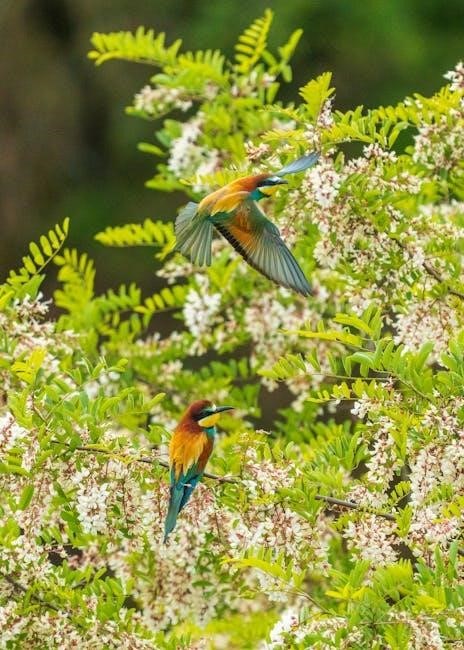
The Science of Color Vision in Birds
Birds possess a unique tetrahedral color vision system, allowing them to perceive a wider spectrum of colors than humans, including ultraviolet wavelengths, enhancing foraging and mating behaviors.
6.1 Avian Visual Perception and Color Gamut
Birds possess a unique tetrahedral color vision system, enabling them to perceive a wider range of colors, including ultraviolet wavelengths invisible to humans. This advanced visual system, driven by four types of cone cells, allows birds to distinguish subtle color variations, enhancing foraging and mate selection. Their color gamut extends beyond human capabilities, with vibrant hues like UV reflectance playing crucial roles in communication and territorial displays. This adaptation highlights evolutionary specializations, where color perception is finely tuned to environmental and social demands, making birds among the most visually adept creatures in the animal kingdom.
6.2 How Birds See Colors Differently from Humans
Birds possess tetrachromatic vision, with four cone cells sensitive to different wavelengths, including ultraviolet light, unlike humans’ trichromatic system. This allows birds to perceive a broader color spectrum and distinguish subtle color variations invisible to humans. For example, feathers that appear uniformly blue to humans may display intricate UV patterns to birds. Their visual system also enhances color intensity and differentiation, aiding in foraging and mate selection. This unique perception highlights how birds experience their environment differently, emphasizing the evolutionary significance of their advanced color vision in their ecological and social interactions.
Cultural and Symbolic Significance of Bird Colors
Bird colors hold profound cultural and symbolic meanings worldwide, inspiring art, literature, and spiritual practices, reflecting their beauty and significance in human societies and traditions.
7.1 Birds as Symbols in Art and Literature
Birds have long been powerful symbols in art and literature, often representing freedom, beauty, and transcendence. Their vibrant colors and unique plumage have inspired countless works, from ancient myths to modern poetry. In many cultures, specific bird species carry deep symbolic meanings, such as the peacock’s association with pride and beauty or the raven’s link to mystery and death. Literary works frequently use birds as metaphors, like Edgar Allan Poe’s raven or the nightingale in Keats’ ode, reflecting their emotional and aesthetic impact. The diversity of bird colors has also influenced visual art, with artists using their hues to evoke emotions and tell stories.
7.2 The Role of Bird Colors in Indigenous Cultures
Bird colors hold profound significance in indigenous cultures, often symbolizing spiritual, ceremonial, and storytelling elements. Many indigenous communities associate specific bird hues with natural elements, ancestors, or divine messages. For instance, the vibrant plumage of macaws is central to rituals in some Amazonian cultures, representing fertility and abundance. Feathers are frequently used in traditional regalia, signifying status, wisdom, or connection to the spirit world. Indigenous oral traditions often feature birds as messengers or creators, with their colors embodying symbolic meanings tied to cultural identity and heritage. This deep connection highlights the integral role of bird coloration in indigenous cultural practices and beliefs.
Bird coloration is a complex and multifaceted trait shaped by evolution, pigments, and environmental interactions. It serves vital functions, from communication and camouflage to social signaling and mate attraction. The interplay of melanin, carotenoids, and structural colors creates the stunning diversity observed in avian plumage. Studies reveal that predation pressures, sexual selection, and habitat conditions drive these adaptations, highlighting their evolutionary significance. Understanding bird coloration offers insights into broader biological and ecological principles, underscoring the importance of continued research into this captivating aspect of avian biology.

